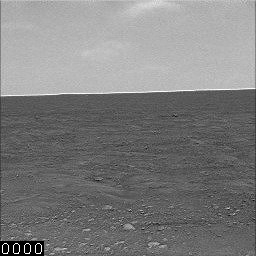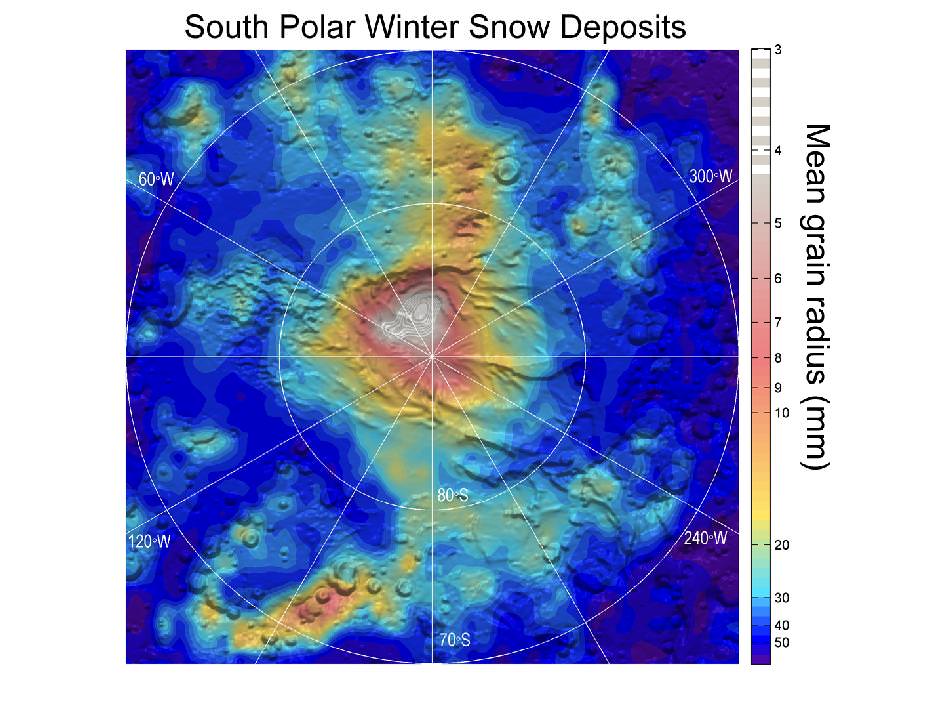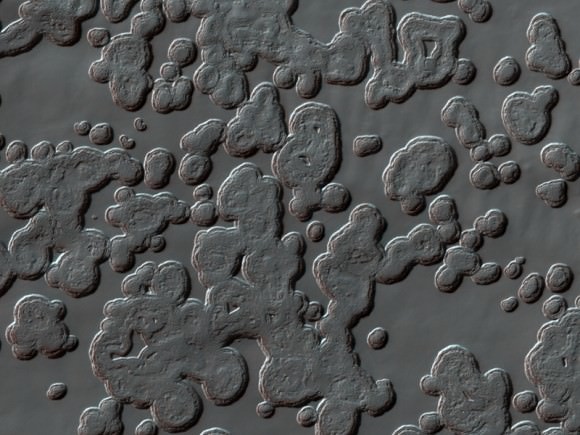Observations by NASA’s Mars Reconnaissance Orbiter have detected carbon-dioxide snow clouds on Mars and evidence of carbon-dioxide snow falling to the surface. Image credit: NASA/JPL-Caltech
In 2008, we learned from the Phoenix Mars lander that it snows in Mars northern hemisphere — perhaps quite regularly – from clouds made of water vapor. But now, Mars Reconnaissance Orbiter data has revealed the clearest evidence yet of carbon-dioxide snowfalls on Mars. Scientists say this is the only known example of carbon-dioxide snow falling anywhere in our solar system.
“These are the first definitive detections of carbon-dioxide snow clouds,” said Paul Hayne from the Jet Propulsion Laboratory, lead author of a new study published in the Journal of Geophysical Research. “We firmly establish the clouds are composed of carbon dioxide — flakes of Martian air — and they are thick enough to result in snowfall accumulation at the surface.”
Scientists have known for decades that carbon-dioxide exists in ice in Mars’ seasonal and permanent southern polar caps. Frozen carbon dioxide, sometimes called “dry ice” here on Earth, requires temperatures of about -125 Celsius (- 193 degrees Fahrenheit), which is much colder than needed for freezing water.
Even though we like to think Mars is a lot like Earth, findings like this remind us that Mars is indeed quite different. But just as the water-based snow falls during the winter in Mars’ northern hemisphere, the CO2 snowfalls occurred from clouds around the Red Planet’s south pole during winter in the southern hemisphere.
“Swiss Cheese Terrain” on Mars South Pole residual CO2 ice cap. Credit: NASA/JPL/University of Arizona
Hayne and six co-authors analyzed data gained by looking at clouds straight overhead and sideways with the Mars Climate Sounder, one of six instruments on the Mars Reconnaissance Orbiter. This instrument records brightness in nine wavebands of visible and infrared light as a way to examine particles and gases in the Martian atmosphere. The analysis was conducted while Hayne was a post-doctoral fellow at the California Institute of Technology in Pasadena.
The data provide information about temperatures, particle sizes and their concentrations. The new analysis is based on data from observations in the south polar region during southern Mars winter in 2006-2007, identifying a tall carbon-dioxide cloud about 500 kilometers (300 miles) in diameter persisting over the pole and smaller, shorter-lived, lower-altitude carbon dioxide ice clouds at latitudes from 70 to 80 degrees south.
“One line of evidence for snow is that the carbon-dioxide ice particles in the clouds are large enough to fall to the ground during the lifespan of the clouds,” co-author David Kass of JPL said. “Another comes from observations when the instrument is pointed toward the horizon, instead of down at the surface. The infrared spectra signature of the clouds viewed from this angle is clearly carbon-dioxide ice particles and they extend to the surface. By observing this way, the Mars Climate Sounder is able to distinguish the particles in the atmosphere from the dry ice on the surface.”
Mars’ south polar residual ice cap is the only place on the Red Planet where frozen carbon dioxide persists on the surface year-round. Just how the carbon dioxide from Mars’ atmosphere gets deposited has been in question. It is unclear whether it occurs as snow or by freezing out at ground level as frost. These results show snowfall is especially vigorous on top of the residual cap.
“The finding of snowfall could mean that the type of deposition — snow or frost — is somehow linked to the year-to-year preservation of the residual cap,” Hayne said.

In 2008, science teams from the Phoenix mission were able to observe water-ice clouds in the Martian atmosphere and precipitation that fell to the ground at night and sublimate into water in the morning. Phoenix scientist James Whiteway and his colleagues said that clouds and precipitation on Mars play a role in the exchange of water between the ground and the atmosphere and when conditions are right, snow falls regularly on Mars.
“Before Phoenix we did not know whether precipitation occurs on Mars,” Whiteway said. “We knew that the polar ice cap advances as far south as the Phoenix site in winter, but we did not know how the water vapor moved from the atmosphere to ice on the ground. Now we know that it does snow, and that this is part of the hydrological cycle on Mars.”
It will be interesting to follow up on this discovery and learn more about Mars CO2 cycle and how it might affect the Martian atmosphere and surface processes.
Source: NASA



This is going to sound like a semantic nit-pick, but it isn’t. I don’t know a WHOLE lot about chemistry, so I’m thinking that perhaps my knowledge on matter phase changes may have a small hole. You mention that precipitation was observed to ”
sublimate into water”. I thought the whole idea of sublimation is to pass directly from solid to gas, thus bypassing liquid altogether. Is that a typo or am I missing some factor here? Thx!
It looks like a typo, seems like they meant water in gas form, not liquid form.
Thx!